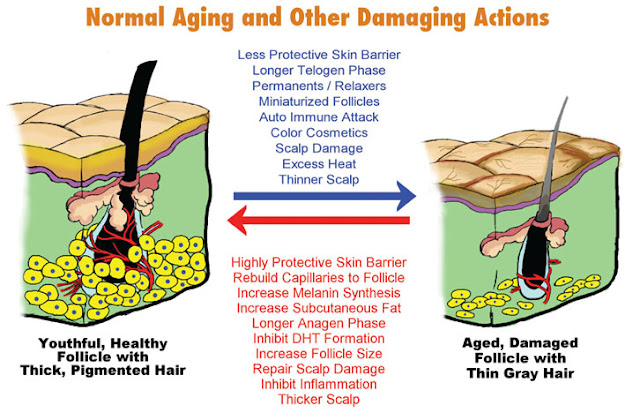Why Men Go Bald and Women Get Thin Hair
No matter how bitterly women complain about hair loss and thinning, they do have to admit that a woman who goes completely bald is a rare sight, one that is usually associated with certain medical conditions. The long known fact that so many men go bald, while women do not, prompted scientists to suspect that baldness is caused by male sex hormones, or androgens. Eventually the male hormone testosterone was established as the main culprit in male pattern hair loss. However, further research revealed a much more complex picture and even now there is still no complete clarity on why people lose their hair.
Each hair follicle goes through the three distinctive phases of growth and decline. The phase of hair growth is called anagen and it lasts for several years. Then a hair follicles enter the short phase or catagen (about two weeks), during which the follicle shrinks and pushes hair out. The resting phase, during which hair follicles are not producing hair, is called telogen and it lasts for several weeks. Then the whole cycle is repeated.
Testosterone that is found in blood is a weak androgen and has little effect on hair growth. However, in hair follicles testosterone can be converted into a much more potent form—dihydrotestosterone or DHT. Normally, DHT stimulates body and facial hair, but has no effect on scalp hair follicles because they lack specific DHT receptors.
The problems begin when certain scalp hair follicles start responding to DHT (develop DHT receptors). In this case, DHT shortens their growth phase (anagen) and eventually causes miniaturization (progressive shrinkage) of the hair follicles. As a result, with each hair cycle, the hair grows thinner and thinner until the follicles start producing thin, barely visible vellus hair instead of thick, beautiful terminal hair.
Men usually have DHT sensitive hair follicles all grouped together, typically on the forehead and on top of the head. These are the areas where hair loss is often profound and noticeable (“male pattern baldness”). In some cases, every single one of the hair follicles on a man’s head can be DHT sensitive, eventually resulting in complete baldness.
Women on the other hand, have diffuse distribution of DHT sensitive follicles. That is why women rarely go completely bald and may just develop thinning hair instead. Since the degree of DHT-dependent hair loss is determined by DHT sensitivity of hair follicles, it is quite possible for a man to have a full head of hair regardless of a high level of DHT.
An enzyme that converts testosterone into DHT is called 5-alpha-reductase (5AR). Normally skin and hair (as well as the liver) contain 5-alpha-reductase Type I, while the prostate contains 5AR Type 2. However, it was found that hair follicles in a balding scalp often contain both types of 5AR—Type I and II. That explains why male pattern hair loss can somewhat be reduced by a drug finasteride—or selective inhibitor of 5AR Type II. Unfortunately, finasteride has little effect on female hair loss.
Yet, while the DHT role in hair loss may seem so well established, recent studies have proven that it is not the whole story (Ellis et al 1998). Today other factors such as follicle inflammation, poor circulation and disrupted skin remodeling have started to come forward as true forces behind the age-old hair loss problem.






Post a Comment